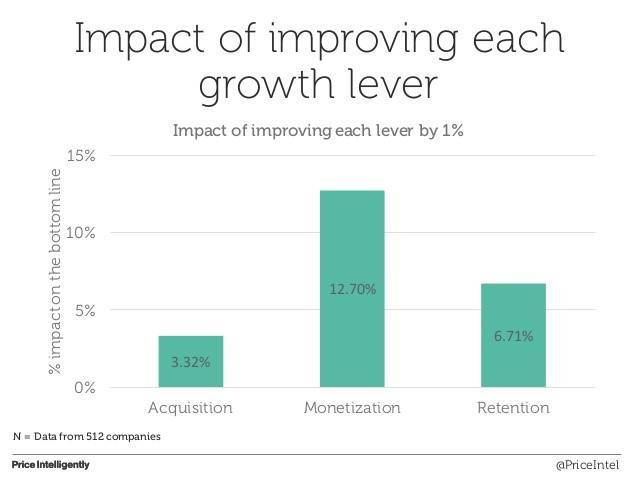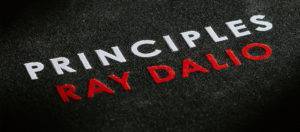Startup pricing is often intimidating. Most entrepreneurs expect that good pricing is derived from a rigid, data-driven, mathematical process. Yet, startups operate in the realm of the unknown, which means access to good information (and data) is a rare luxury.
Because of this, pricing for startups is undoubtedly much messier and could seem like shooting in the dark.
At the same time, pricing is without a doubt one of the most important decisions related to the success of your business:

(Source)
When you are thinking about growth (and as a startup, growth is usually a prerequisite for survival), you are usually thinking about user acquisition first, and user retention second. However, monetization is actually the most efficient growth driver.
As can be seen in the graph above, a 1% improvement in your monetization could lead to a 12.7% impact on the bottom line, which is about 4 times more efficient than customer acquisition.
The reason startup pricing is scary is that people intuitively realize that pricing matters a lot, and at the same time have the feeling that they don’t have the needed tools to do the perfect job.
Startups, however, are always messy. Striving for perfection is a luxury you rarely have, and pricing is no exception despite being mathematical in nature.
So, in this guide, we’ll try to help you make the right startup pricing decisions.
Table of Contents:
1. Startup Pricing: From First Principles
Mathematically speaking, the goal of product pricing is pretty straightforward.

(source)
Price and sales volume are negatively correlated. The higher the price, the fewer people can afford your offering. Your goal is to find the sweet spot that maximizes revenue (and profit).
Of course, the lack of data means that you have to start from somewhere. So how do you decide your initial price?
1.1 Price From Cost
The first method is to calculate your costs (mainly the cost of goods sold) and to add a profit margin that you think is going to be sufficient to cover your other expenses and to reach breakeven for a realistic sales volume.
While it’s very important to understand your cost structure, this isn’t an ideal pricing strategy for startups because the data (costs and predicted sales volume) you’d use in your calculation could be flawed, leading to wrong conclusions. It’s easy to underestimate costs and over-estimate sales volume.
This calculation is important in order to gain an understanding of the minimum price you can offer while remaining profitable. At the same time, you need to keep in mind that customers don’t care about your costs – they care exclusively about the value your product/service brings them.
1.2 Price From Value
The perceived value of your offering in relation to your price is all that matters to the customer. The problem is that, unlike costs, value is extremely difficult to pin down in rigid, monetary terms. This issue is made even more difficult by the fact that each customer has a different willingness to pay – the maximum dollar amount they are willing to part with for your service.
Value is meaningless in a vacuum – it gains meaning only in the context of the needs of the customer, their purchase power, and the alternatives they have for solving the problem (competition).
An enterprise-level corporation has different problems, priorities, and orders of magnitude more purchasing power than a low socio-economic class individual. This information should play a big role in your value-driven pricing decisions, which means that your first job is to get to know your target customers (your minimum viable segment) as well as you can.
Specifically, you need to understand how your target customers are currently addressing the problem you are trying to solve and how much money and time they are spending to do it.
In practice, your first step is to do some competitor research to gain a basic understanding of the price/value relationship in your market and to be able to place your offering in context. Keep in mind that as a startup you are most likely building something at least slightly innovative, which means you wouldn’t be able to make direct comparisons with the current players in your market.
Chose an initial price based on this information, but make sure that the price/perceived value ratio works in your favor. Customers are reluctant to make changes and to take risks with new products, so you need to make sure the purchase decision seems like a no-brainer.
1.3 Iterations and Experimentation
Chances are your initial chosen price wasn’t a bulls-eye hit.
This means that you would have to do some experiments in order to optimize your price for the maximum possible revenue. After choosing your initial price and launching, you’ll have access to data, so you will be able to start to iterate and do more precise tests.
For example, you could run a test with the 10/5/20 rule. Kevin Hale from Y Combinatory recommends having a perceived value equal to 10x the price of your offering and then raising your price by 5% periodically until 20% of your customers push back. This should get you closer to the optimal price.
Another thing you can do is small-scale ad or sales campaigns with different prices (A/B tests). You should measure the conversion rate, sales volume, and finally total revenue for each campaign. The benefit of these tests compared to the 10/5/20 is that you can try out radically different pricing options (very useful when you are targeting businesses with high purchase power – should I charge them $1k, $10k, $100k?).
You can also include different pricing tiers for your offering. Which one is the most popular, and what happens when you introduce different tiers? This is a good idea not only because it helps you nail down your perfect pricing, but because it helps your users gain a better perception of value. For example, if your base tier is $9.99 per month, but $5 extra gives you a lot of desirable benefits, it’s conceivable that you would generate a lot more revenue compared to scenarios in which you are charging $10 or $15 without pricing tiers.
2. Startup Pricing Mistakes
2.1 Thinking that pricing is a decision, rather than a process.
Most entrepreneurs think that they need to settle on a price and stick to it out of fear that any substantial pricing changes would upset past or future customers. While this is a legitimate concern for big businesses, startups can’t afford to think that way.
Your whole business is in the test phase, and so is your pricing. Finding the right answer undoubtedly includes experimentations and changes. While some people might be turned off from this, most people (especially early adopters) are willing to show understanding.
More importantly, getting your pricing right is more important than turning away some potential users. It is a prerequisite for sustainable growth. This means that you need to accept the fact that pricing is a process, and changes are inevitable.
2.2 Thinking you can win a price war.
You are a startup, which means that the bigger players in your industry have deeper pockets. The way to win as a startup is not through brute force, but rather through innovation and differentiation. You will find customers not by offering the same thing cheaper (you simply can’t), but by offering something valuable and sufficiently different. This means that more often than not you can afford to charge a premium price in your market. (Free trials and freemium business models are totally fine, they are an acquisition strategy, not a pricing strategy.)
2.3 Underestimating your costs.
The fact that you are doing something new means you don’t have access to good cost data. This means you cannot afford to aim for razor-thin margins. It’s simply too easy to underestimate costs because something unexpected always comes up.
2.4 Misunderstanding the value customers are deriving from your product or service.
Value is a very amorphous concept, which means it’s hard to pin down exactly. Yet, customers are making purchase decisions based on the value/price relationship – they don’t care about your costs. Because of this, understanding the value of your offering in-depth is one of the most important things in order to make the right pricing decisions. This is usually done first by comparing your offering to the offering of competitors, but later on (and more importantly) by talking to customers and understanding why they are using your product or service and what it brings to their lives.
2.5 Focusing on the wrong customers.
The obvious thing that comes to mind is not to focus on the wrong market and market segment. While this is key in principle for startups, it’s not the only danger when it comes to pricing.
When you are offering something innovative your first customers would be the so-called first adopters. Generally speaking, these are customers who are willing to take risks, and usually, they are not very price sensitive.
It’s wrong to assume that the potential customers who are turning you away are always doing so because of a price/value discrepancy. Late adopters wouldn’t invest in a new, untested offering even if it was cheap simply because they don’t want to take the risk. This means that it’s a mistake to try to fit your pricing decisions on the demands of people who are not ready to adopt yet.
3. Startup Pricing Tips
3.1 Use price localization.
As a startup, you are unlikely to be able to put in the effort needed to offer localized prices in different countries. That said, displaying prices in the country’s currency and having a landing page in the country’s language could be useful nonetheless.
3.2 Gather feedback from your churning customers.
“We hate to see you leave…”
Gathering feedback from customers who are leaving your business is very useful because you can see if the price is a major reason for their decision or not.
3.3 Experiment with promotions.
Does lowering the price temporarily lead to a lot of revenue growth? If it does, it might be worth testing permanent price reductions.
3.4 Experiment with pricing tiers.
Having multiple pricing tiers is generally speaking a great idea, but it is also a useful tool to judge the effects on your bottom line if you add/remove certain pricing tiers.
3.5 Experiment with upselling and annual subscriptions.
If you have tiers, its’ a good idea to prompt your users at the right time to upgrade. Most companies only ask about upgrades or an annual subscription at the initial checkout. This is the worst time to ask because the customers don’t have a good idea of the value you are offering. Prompting users for an upgrade or an annual subscription with notifications and emails after a certain time could give better results.
3.6 Offer months off and freebies rather than just a % discount.
While the difference might seem semantic, people don’t have a good intuitive sense of percentages. Because of this, getting a month free could feel much more tangible and as a result – enticing, compared to getting 8% off.
4. In Summary
Figuring out and setting the right prices for your products and services is one of the key ingredients in the development of a successful startup, one that generates value that customers are happy to pay for and recommend. Treat pricing as a process, rather than a single decision.
First, choose your initial pricing based on customer interviews, A/B tests, and competitor research. You are aiming for a good perceived value to price ratio, which means that you need to understand in-depth the comparative value you are bringing to your potential customers.
Second, iterate and run further experiments from that point. Your initial pricing decision wouldn’t be perfect, so make adjustments in order to optimize your pricing and maximize revenue.





